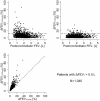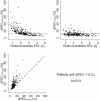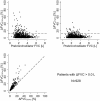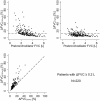A comparative study of bronchodilator response: utilizing pre-bronchodilator versus predicted normal values
- PMID: 38273287
- PMCID: PMC10809550
- DOI: 10.1186/s12890-024-02859-4
A comparative study of bronchodilator response: utilizing pre-bronchodilator versus predicted normal values
Abstract
Background: A positive bronchodilator response has been defined as a 12% increase in the forced expiratory volume in one second (FEV1) or forced vital capacity (FVC) from their respective pre-bronchodilator values, combined with at least a 0.2 L absolute change. Recent recommendations suggested the use of the percent change in FEV1 and FVC relative to their predicted normal values without having applied them in patients with airflow obstruction. The aim of the current study was to compare the two approaches over a wide range of pre-bronchodilator FEV1 and FVC values.
Methods: A retrospective review of consecutive patients undergoing spirometry and bronchodilator testing was completed. The change in FEV1 and FVC with a bronchodilator was expressed relative to the pre-bronchodilator and predicted normal FEV1 and FVC.
Results: In 1,040 patients with a non-paradoxical change in FEV1, 19.0% had a ≥ 12% change in FEV1 using their pre-bronchodilator value compared to 5.7% using their predicted normal value. For FVC, the respective values were 12.7% vs. 5.8%. The difference was retained in patients with a ≥ 0.2 L change in FEV1 or FVC. In unobstructed patients, the upper threshold (two standard deviations above the mean) of the bronchodilator response was 14% for FEV1 and 10% for FVC using predicted normal values.
Conclusions: Expressing the percent change in FEV1 and FVC relative to predicted normal values reduces the over-estimation of the bronchodilator response, especially in patients with a very low pre-bronchodilator FEV1, including in those with a ≥ 0.2 L change in FEV1. Irrespective of pre-bronchodilator values, a ≥ 14% change in FEV1 and ≥ 10% change in FVC relative to the predicted normal values could be considered a positive bronchodilator response.
Keywords: Bronchodilator response; Pulmonary function testing; Spirometry.
© 2024. The Author(s).
Conflict of interest statement
Not applicable.
Figures





Similar articles
-
A New Bronchodilator Response Grading Strategy Identifies Distinct Patient Populations.Ann Am Thorac Soc. 2019 Dec;16(12):1504-1517. doi: 10.1513/AnnalsATS.201901-030OC. Ann Am Thorac Soc. 2019. PMID: 31404502 Free PMC article.
-
Post-bronchodilator spirometry reference values in adults and implications for disease management.Am J Respir Crit Care Med. 2006 Jun 15;173(12):1316-25. doi: 10.1164/rccm.200601-023OC. Epub 2006 Mar 23. Am J Respir Crit Care Med. 2006. PMID: 16556696
-
Combined Forced Expiratory Volume in 1 Second and Forced Vital Capacity Bronchodilator Response, Exacerbations, and Mortality in Chronic Obstructive Pulmonary Disease.Ann Am Thorac Soc. 2019 Jul;16(7):826-835. doi: 10.1513/AnnalsATS.201809-601OC. Ann Am Thorac Soc. 2019. PMID: 30908927 Free PMC article.
-
GOLD Science Committee recommendations for the use of pre- and post-bronchodilator spirometry for the diagnosis of COPD.Eur Respir J. 2025 Feb 6;65(2):2401603. doi: 10.1183/13993003.01603-2024. Print 2025 Feb. Eur Respir J. 2025. PMID: 39638416 Free PMC article. Review.
-
Flow and volume response to bronchodilator in patients with COPD.Acta Biomed. 2018 Oct 8;89(3):332-336. doi: 10.23750/abm.v89i3.5631. Acta Biomed. 2018. PMID: 30333454 Free PMC article. Review.
References
-
- Miller RA, Walker RD, Carson J, Coles M, Coyne R, Dalsgaard I, Gieseker C, Hsu HM, Mathers JJ, Papapetropoulou M, et al. Standardization of a broth microdilution susceptibility testing method to determine minimum inhibitory concentrations of aquatic bacteria. Dis Aquat Organ. 2005;64(3):211–22. doi: 10.3354/dao064211. - DOI - PubMed
-
- Stanojevic S, Kaminsky DA, Miller MR, Thompson B, Aliverti A, Barjaktarevic I, Cooper BG, Culver B, Derom E, Hall GL et al. ERS/ATS technical standard on interpretive strategies for routine lung function tests. Eur Respir J 2022, 60(1). - PubMed
-
- Tan WC, Vollmer WM, Lamprecht B, Mannino DM, Jithoo A, Nizankowska-Mogilnicka E, Mejza F, Gislason T, Burney PG, Buist AS, et al. Worldwide patterns of bronchodilator responsiveness: results from the Burden of Obstructive Lung Disease study. Thorax. 2012;67(8):718–26. doi: 10.1136/thoraxjnl-2011-201445. - DOI - PMC - PubMed
MeSH terms
Substances
Grants and funding
LinkOut - more resources
Full Text Sources
Medical

